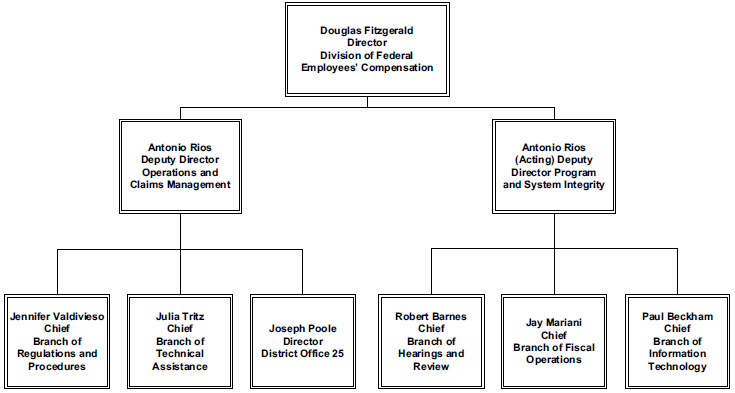Fed Employees Comp (DFEC)
Division of Federal Employees’ Compensation (DFEC)
Mission Statement
The Federal Employees’ Compensation Act provides workers’ compensation coverage to three million Federal and Postal workers around the world for employment-related injuries and occupational diseases. Benefits include wage replacement, payment for medical care, and where necessary, medical and vocational rehabilitation assistance in returning to work. The program has 12 district offices nationwide.
Program Leadership

What our Program Does
The Division of Federal Employees’ Compensation adjudicates new claims for benefits and manages ongoing cases; pays medical expenses and compensation benefits to injured workers and survivors; and helps injured employees return to work when they are medically able to do so.
In FY 2009, 129,690 new cases were created. The program provided 253,000 workers and survivors approximately $2.7 billion in benefits for work-related injuries or illnesses. Of these benefit payments, over $1.7 billion was for wage-loss compensation, $848 million for medical and rehabilitation services, and $138 million for death benefit payments to surviving dependents.
Services our Customers can Expect
Prompt Adjudication. If you are an injured worker, you can expect timely adjudication of your compensation claim:
- For traumatic injuries, this means a decision within 45 days of receipt in all but the most complex cases.
- For simple occupational illness cases, a decision will be issued within 90 days of receipt.
- For most occupational illness cases, which require more extensive evidentiary development, a decision should be forthcoming within six months of receipt.
- For very complex occupational illness cases, a decision should be rendered within 10 months of receipt.
Prompt Payment of Medical Bills. Medical bills, whether submitted directly by the providers or as reimbursement requests by injured workers, are usually processed within 28 days of receipt. For any bill which is not payable, an Explanation of Benefits describing the reason for non-payment is issued to the party who submitted the bill.
Prompt Payment of Compensation. Injured workers can also expect prompt payment of claims for wage loss in accepted cases. Where medical evidence supports disability for work, compensation payments are usually made within 14 days of submittal to the district office by the employing agency.
Assistance in Returning to Work. The Federal Employees’ Compensation Act gives injured workers the right to reclaim their Federal jobs within one year of the onset of wage loss. We will do everything we can to help employees return to work during that time period, and, if necessary, beyond. Injured workers and employing agencies can expect timely case management services, which include the following:
- Assignment of a registered nurse if the injured employee cannot return to work soon after the injury. The nurse ensures that appropriate medical care is provided and assists the worker in returning to employment.
- Referral to a medical specialist for a second opinion examination where required by the worker’s medical condition or the program’s need for additional medical information.
- Referral for vocational rehabilitation services if the employee is unable to return to work at the employing agency or in his or her previous job category.
How the Program is Funded
Employing agencies are responsible for reimbursing the Division of Federal Employees’ Compensation for their workers’ compensation expenses. This reimbursement occurs once each year through the chargeback process.
The administrative cost of the services provided by the Division of Federal Employees’ Compensation is very low. Overhead is just 4% of benefits, and Federal workers’ compensation costs are only 1.8% of total Federal and Postal payrolls, compared to 2.3% for private insurance and state funds.
Also, because disputes in claims under the Federal Employees’ Compensation Act are resolved administratively, the Federal government avoids time-consuming and expensive litigation, which in some non-Federal workers’ compensation systems can account for as much as 46% of payout.
Reference: United States Department of Labor.